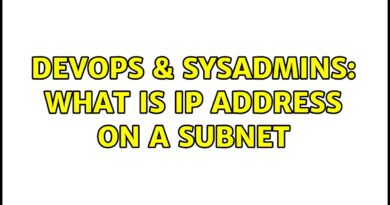Unraveling the TCP IP Model A Deep Dive, What Does TCP/IP Do? Difference between TCP and IP.
What Does TCP/IP Do?
The main work of TCP/IP is to transfer the data of a computer from one device to another. The main condition of this process is to make data reliable and accurate so that the receiver will receive the same information which is sent by the sender. To ensure that, each message reaches its final destination accurately, the TCP/IP model divides its data into packets and combines them at the other end, which helps in maintaining the accuracy of the data while transferring from one end to another end.
What is the Difference between TCP and IP?
TCP and IP are different protocols of Computer Networks. The basic difference between TCP (Transmission Control Protocol) and IP (Internet Protocol) is in the transmission of data. In simple words, IP finds the destination of the mail and TCP has the work to send and receive the mail. UDP is another protocol, which does not require IP to communicate with another computer. IP is required by only TCP. This is the basic difference between TCP and IP.
How Does the TCP/IP Model Work?
Whenever we want to send something over the internet using the TCP/IP Model, the TCP/IP Model divides the data into packets at the sender’s end and the same packets have to be recombined at the receiver’s end to form the same data, and this thing happens to maintain the accuracy of the data. TCP/IP model divides the data into a 4-layer procedure, where the data first go into this layer in one order and again in reverse order to get organized in the same way at the receiver’s end.
For more, you can refer to TCP/IP in Computer Networking.
Layers of TCP/IP Model
Application Layer
Transport Layer(TCP/UDP)
Network/Internet Layer(IP)
Data Link Layer (MAC)
Physical Layer
The diagrammatic comparison of the TCP/IP and OSI model is as follows:
TCP/IP and OSI
TCP/IP and OSI
1. Physical Layer
It is a group of applications requiring network communications. This layer is responsible for generating the data and requesting connections. It acts on behalf of the sender and the Network Access layer on the behalf of the receiver. During this article, we will be talking on the behalf of the receiver.
2. Data Link Layer
The packet’s network protocol type, in this case, TCP/IP, is identified by the data-link layer. Error prevention and “framing” are also provided by the data-link layer. Point-to-Point Protocol (PPP) framing and Ethernet IEEE 802.2 framing are two examples of data-link layer protocols.
3. Internet Layer
This layer parallels the functions of OSI’s Network layer. It defines the protocols which are responsible for the logical transmission of data over the entire network. The main protocols residing at this layer are as follows:
IP: IP stands for Internet Protocol and it is responsible for delivering packets from the source host to the destination host by looking at the IP addresses in the packet headers. IP has 2 versions: IPv4 and IPv6. IPv4 is the one that most websites are using currently. But IPv6 is growing as the number of IPv4 addresses is limited in number when compared to the number of users.
ICMP: ICMP stands for Internet Control Message Protocol. It is encapsulated within IP datagrams and is responsible for providing hosts with information about network problems.
ARP: ARP stands for Address Resolution Protocol. Its job is to find the hardware address of a host from a known IP address. ARP has several types: Reverse ARP, Proxy ARP, Gratuitous ARP, and Inverse ARP.
The Internet Layer is a layer in the Internet Protocol (IP) suite, which is the set of protocols that define the Internet. The Internet Layer is responsible for routing packets of data from one device to another across a network. It does this by assigning each device a unique IP address, which is used to identify the device and determine the route that packets should take to reach it.
4. Transport Layer
The TCP/IP transport layer protocols exchange data receipt acknowledgments and retransmit missing packets to ensure that packets arrive in order and without error. End-to-end communication is referred to as such. Transmission Control Protocol (TCP) and User Datagram Protocol are transport layer protocols at this level (UDP).
TCP: Applications can interact with one another using TCP as though they were physically connected by a circuit. TCP transmits data in a way that resembles character-by-character transmission rather than separate packets. A starting point that establishes the connection, the whole transmission in byte order, and an ending point that closes the connection make up this transmission.
UDP: The datagram delivery service is provided by UDP, the other transport layer protocol. Connections between receiving and sending hosts are not verified by UDP. Applications that transport little amounts of data use UDP rather than TCP because it eliminates the processes of establishing and validating connections.
5. Application Layer
This layer is analogous to the transport layer of the OSI model.
ipv4



